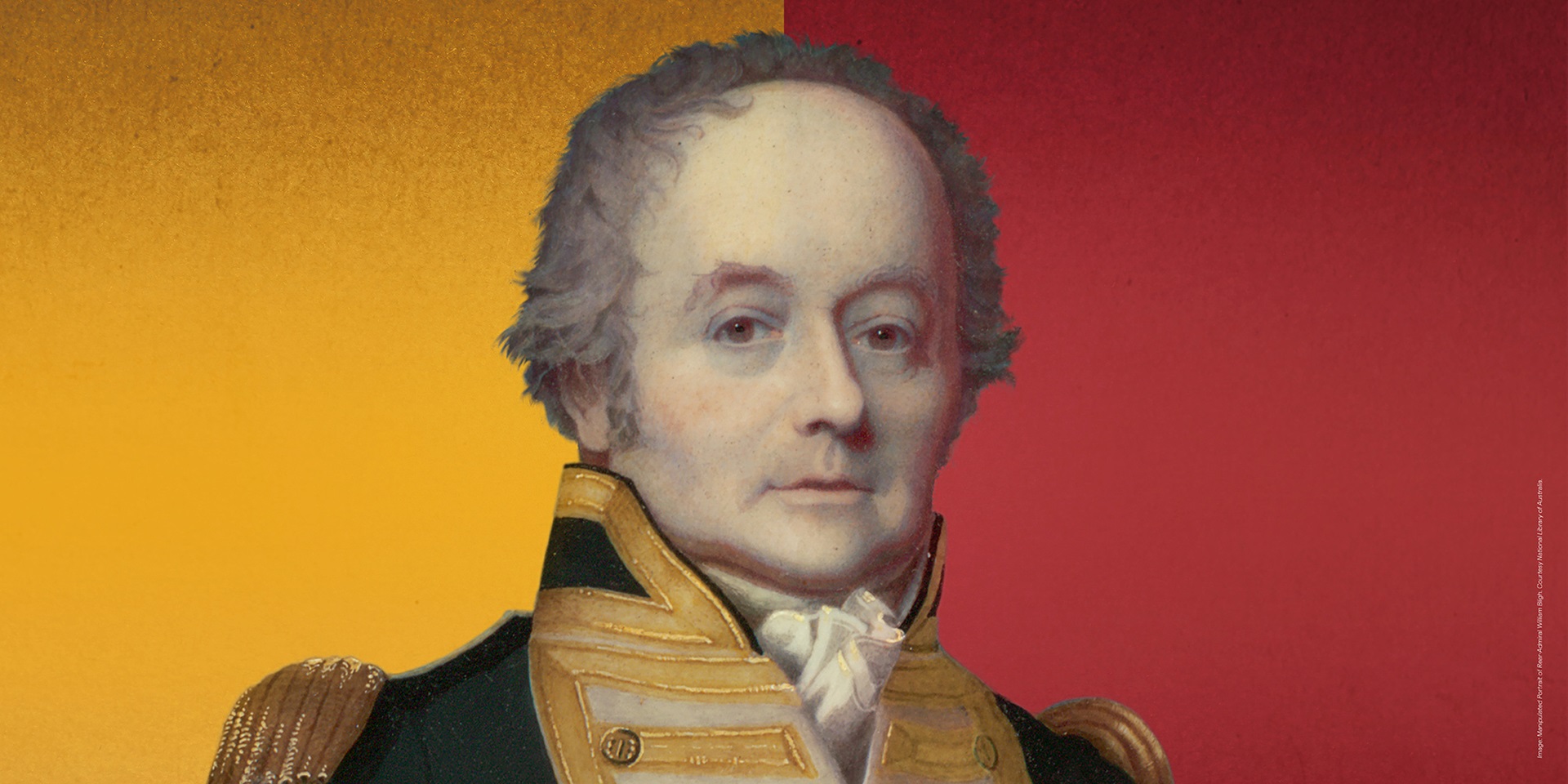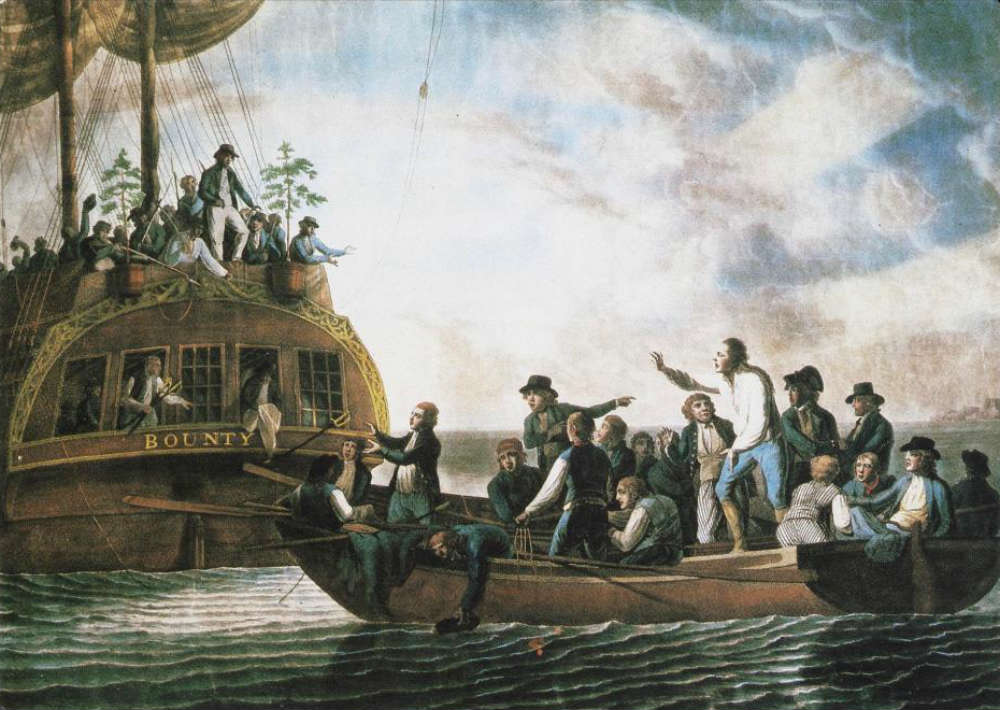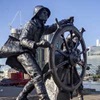
The story of the mutiny on the Bounty remains one of the most infamous events in the history of seafaring voyages, with its two protagonists – William Bligh and Fletcher Christian – immortalised in history and popular culture. The mythology that surrounds the mutiny has painted Bligh as an abusive tyrant who had a tendency for violence, whereas Christian remains the virtuous hero who saved the day. How did Bligh get this bad reputation and why is it still so ingrained in society’s consciousness today?
What was the mutiny on the Bounty?
As captain of HMS Bounty, William Bligh was tasked with transplanting over 1000 breadfruit plants from Tahiti to the British colonies in the West Indies. Departing England on 23 December 1787, Bligh and his crew of 43 men arrived in Tahiti 10 months later in October 1788. Forced to stay for five months to allow for the cultivation and transfer of the breadfruit plants, the ship departed Tahiti on 5 April 1789.
Not long after leaving Tahiti however, mutiny struck. Bligh, along with 18 other men, were forced into a small, open boat with only five days’ worth of food and water, left in the middle of the Pacific Ocean. Miraculously, Bligh expertly sailed to the Dutch settlement of Coupang on the island of Timor, with his crew surviving the 42-day voyage. Meanwhile, after a failed attempt to establish a settlement on Tubuai, Christian and the mutineers sailed back to Tahiti before settling on Pitcairn Island.
What caused the mutiny?
In his own account of the mutiny, William Bligh believed the mutineers wished to return to Tahiti: [1]
I can only conjecture that the mutineers had assured themselves of a more happy life among the Otaheiteans, than they could possibly have in England; which, joined to some female connections, have most probably been the principal cause of the whole transaction.
Tahiti had long been written about as a ‘sailor’s paradise’, where the inhabitants lived a relatively easy life. During their stay, many crew members formed relationships and enjoyed the freedom that came with not following the rigid routine of being on-board the ship. As historian Greg Dening argues, this is the time when Bligh should have emphasised his authority, but being too preoccupied with the breadfruit and diplomacy, his crew began to reject the order of the ship instead. [2]
The other reason commonly cited for the mutiny (and highly favoured by Hollywood) is Bligh’s cruel treatment of the crew. Edward Christian, Fletcher’s elder brother and a barrister, published ‘the real causes and circumstances of that most melancholy event, the Mutiny on board the Bounty.’[3] Having interviewed various men involved in the mutiny, they declared that Bligh frequently swore and threatened them. According to the men interviewed, Bligh abused Fletcher Christian ‘more frequently and roughly than the rest of the officers’, and he regularly ‘shook his fist in Christian’s face.’ [4]

Postcard depicting a painting of the mutineers turning Lieutenant Bligh adrift from the Bounty, before 1816, ANMM Collection Gift from Rhonda Coleman, ANMS1140[037]
What sent Fletcher Christian over the edge were two consecutive events that occurred on the 26 and 27 April 1789. In the first incident, the Bounty had stopped at Nomuka (Tonga) and Christian was sent to gather water and other supplies, with explicit orders to not fire at ‘the natives’. Christian and the party returned unsuccessful, as they were constantly harassed and unable to retaliate without the use of arms. Bligh abused Christian, and allegedly said, ‘God damn your blood, why did you not fire, you an officer!’ [5] In the second incident that occurred on the 27 April, Bligh believed that some of his coconuts were missing and accused Christian of stealing them, calling him a ‘scoundrel’, ‘thief’ and other abusive names. As punishment, Bligh reduced the entire crew’s daily rations of food. [6]
It was this account that soured public opinion of Bligh, with Edward Christian’s Appendix acting as a modern day smear campaign, one that would seal Bligh’s fate as a villain.
Bligh in popular culture
During the nineteenth century, the fascination with the mutiny was kept in public focus by the finding of the mutineers (or those who were left and their descendants), hidden away from the world on Pitcairn Island. In the twentieth century, Hollywood and the rest of the world went crazy with retellings and re-enactments of the mutiny on the Bounty. In 1932, authors Charles Nordhoff and James Norman Hall published the novel, Mutiny on the Bounty that went on to sell 25 million copies and was translated into 35 languages. [7] The novel presents Bligh as violent and foul-mouthed, with a tendency to flog his crew regularly for minor issues.
Damn your eyes! I’m tired of you and your complaints! The first man to complain from now on will be seized up and flogged.
The novel inspired the scripts of three Hollywood films, including: Mutiny on the Bounty (1935) starring Clark Gable as Fletcher Christian and Charles Laughton as William Bligh; Mutiny on the Bounty (1962) with Marlon Brando and Trevor Howard; and The Bounty (1984) with Mel Gibson and Anthony Hopkins. All three films (particularly 1935 and 1962) present Bligh as a brutal and sadistic captain, who is rightly ousted by the virtuous Christian.
At the beginning of the 1935 film, Christian advises Bligh to ‘not be too harsh’ with the men, to Bligh disregards this, stating that seamen ‘respect but one law, the law of fear’. Bligh then regularly orders the flogging of his crew for the slightest injustice, at one point even a dead man is flogged. He also keelhauls a seaman (form of punishment where a sailor was tied to a line that was looped beneath the vessel, thrown overboard and then dragged under the ship’s keel) which results in his death.
I’ve never known a better seaman, but as a man, he’s a snake. He doesn’t punish for discipline, he likes to see men crawl.
The 1962 film also presents Bligh as an abusive tyrant, with Fletcher Christian disgusted by the ‘incredible relish’ his captain takes in inflicting punishment: [8]
My point is that cruelty with purpose is not cruelty – its efficiency. Then a man will never disobey once he’s watched his mate’s backbone laid bare. He’ll see the flesh jump, hear the whistle of the whip for the rest of his life.
Both films presented Bligh as an oppressor, with the mutiny instigated by Christian completely justified. This idea (unfortunately for Bligh) has remained in public consciousness, with popular shows such as The Simpsons and Star Trek recreating their own mutiny on the Bounty. Is Hollywood’s portrayal of William Bligh accurate though? Was he a villain? Did he flog his men indiscriminately?
Fact-checking Hollywood’s representations
According to historian Greg Dening, Bligh (on both breadfruit voyages) flogged ‘fewer of his crew … than any other captain who came into the Pacific in the eighteenth century.’ [9] While Bligh did flog his men, he didn’t order the punishments indiscriminately as shown in the movies – and he never flogged a dead man. Bligh didn’t ‘relish’ inflicting punishment, for he wrote in his log four months into the voyage, ‘until this afternoon I had hoped I could have performed the voyage without punishment to anyone’. [10] Similarly, there was no incident of keelhauling, the practice had long been abandoned by the Royal Navy before Bligh set sail in the Bounty. Contrary to the evil picture Hollywood painted of Bligh, he cared a great deal about his men and their health, making sure they were given hot breakfasts and hired a fiddler so the men could dance as regular exercise. Bligh’s main source of opposition was his language, not his violence. Hollywood emphasised and exaggerated the violence as it ‘makes larger heroes of those rebelling against it’ – which is why Christian has been remembered as a hero and Bligh a villain. [11]
Want to learn more about William Bligh? Be sure to visit our upcoming exhibition, Bligh – Hero or Villain launching on Friday, 26 July where you can decide for yourself if popular culture has been kind or harsh to this infamous figure.
References:
[1] William Bligh, A Narrative of the Mutiny on Board H.M. Ship Bounty; and the subsequent voyage of part of the crew, in the ship’s boat, from Tofoa, one of the Friendly Islands, to Timor, a Dutch settlement in the East Indies, 4 vol in 1, Georgian House, Melbourne, 1952 p 9.
[2] Greg Dening, Mr Bligh’s Bad Language: Passion, power and theatre on the Bounty, Cambridge University Press, 1992, p. 85.
[3] Ed Christian, letter to Stephen Barney Esquire, 15 May 1794, quoted in Minutes of the proceedings of the court-martial held at Portsmouth, August 12, 1792, on ten persons charged with mutiny on board His Majesty's ship the Bounty: with an appendix containing a full account of the real causes and circumstances of that unhappy transaction, the most material of which have hiherto been withheld from the public, 4 vol in 1, Georgian House, Melbourne, 1952 p 61.
[4] Ibid, p 63.
[5] Ibid.
[6] Ibid.
[7] Sylvie Largeaud-Ortega, ‘Nordhoff and Hall’s Mutiny on the Bounty: A Piece of Colonial Historical Fiction’, The Bounty from the Beach, ANU Press, 2018, pp 125-6.
[8] Trevor Howard as William Bligh in the 1962 film, Mutiny on the Bounty.
[9] Dening, Mr Bligh’s Bad Language, p. 62.
[10] Ibid, p. 65.
[11] Ibid.
